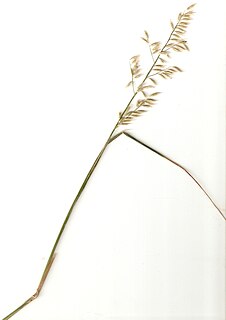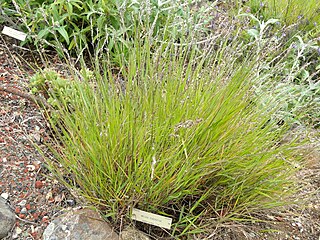
Oplismenus compositus, the running mountaingrass, is a species of perennial plant from the family Poaceae that can be found throughout Asia, Africa, Australia, South America, Mexico and Hawaii.
Melica argyrea is a species of grass found in Argentina, Brazil, and Uruguay.
Melica argentata is a species of grass endemic to Chile.
Melica longiflora is a grass species in the family Poaceae that is endemic to Chile where it can be found from Coquimbo to Talca.
Melica bonariensis is a species of grass endemic to Argentina where it can be found in such provinces as Buenos Aires, La Pampa, and Rio Negro.
Melica brasiliana, is a grass species in the family Poaceae that is endemic to Brazil and southern South America.
Melica subflava, is a species of grass that is endemic to China.

Melica violacea, is a species of grass endemic to Chile.

Melica teneriffae, is a grass species in the family Poaceae that is endemic to the Canary Islands.
Melica stuckertii, is a grass species in the family Poaceae that is endemic to Argentina and southern South America.
Melica eremophila is a species of grass that is native to South America.
Melica glabrescens is a species of grass found in Buenos Aires and Río Negro, Argentina.
Melica paulsenii is a species of grass endemic to Chile where it grows along the coastal cordillera at 50–700 metres (160–2,300 ft) above sea level.
Melica mollis is a species of grass endemic to Chile where it grows in rock crevices at 340 metres (1,120 ft) above sea level.
Melica minuta is a species of grass that can be found in North Africa, Western Asia, on Iberian Peninsula and in Southeast Europe.
Melica patagonica is a species of grass that is endemic to South America.
Melica radula is a species of grass endemic to China. It grows on grassy mountain slopes and larch forests at 300–1,200 metres (980–3,940 ft) above sea level.
Melica longiligulata is a species of grass endemic to Sichuan province of China.
Agrostis tolucensis is a species of grass which is found in South America, the United States, and Mexico.
Festuca polycolea is a species of grass which is endemic to India.


